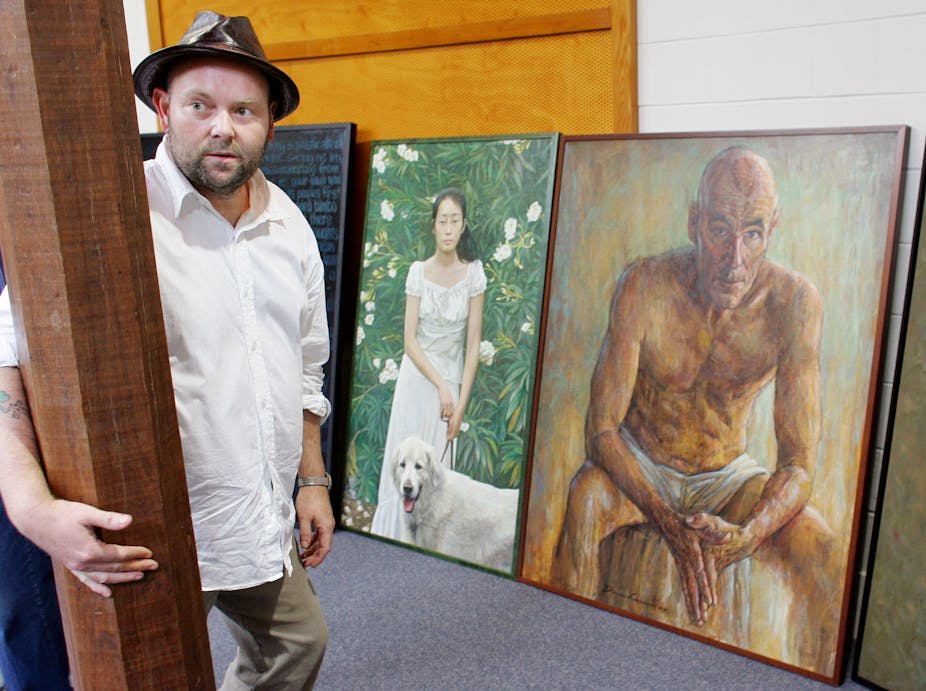Archibald Prize-winning artist Adam Cullen died at his Blue Mountains home over the weekend. The 47 year old had been seriously ill for some time.
Academics say Cullen will be remembered for his distinctive portraits and his confronting imagery. Here, art historians reflect on his legacy.
Associate Professor Joanna Mendelssohn, School of Art History and Art Education, College of Fine Arts at the University of New South Wales:
Adam’s most distinctive quality as an artist was the way in which he openly and joyously indulged in “borderlining” – seeing how far he could get away with irritating the hierarchy.

So with his prize-winning portrait of David Wenham, he recognised that the Archibald is one big media circus for popular taste, and played to it. Wenham is painted in character as one of the murderous emotional cripples in the film The Boys. He treats the figure as passionate, intense, dangerous – on a pastel yellow ground.
Aesthetically the choice is spot on, the yellow tones and orange streaks of Wenham’s hair contrast so sweetly with the flat pastel ground. But there is the extra frisson of pleasure in putting such a dark character in the context of soft pastels.
I think, though, his finest hour was in a performance piece at the Museum of Contemporary Art in 2005. The context was the climate of government-inspired paranoia about sedition and proposed restrictions on free speech.
The performance was called Home Economics and consisted of Cullen and Cash Brown standing at a table with various domestic appliances and easily purchased ingredients. Then as Adam Cullen read from sources found on the internet, Brown drew accompanying diagrams to show how weapons of mass destruction could be made by all.

As well as the different formulae for increasing the volatility and explosive power (polystyrene makes a nasty brew), they showed their own varieties on the theme of domestic explosions. This included an all-Australian battered sav, and a claymore mines from a plastic microwave omelette maker. The detonators were sparklers and items easily found in hobby shops and hardware stores. The claymore was clamped with velcro.
It turned out that the petrol had been replaced with coloured water for the performance, and only the sparklers and candles were real.
Curiously enough, this performance was not covered by the media, although journalists were present (and at least one story was filed). It wasn’t clear whether this reticence was for the benefit of the artists, or for fear of possible terrorists learning how to use Google. It does however live on in the memories of all who were present.
He will be missed.
Dr Vivien Gaston, art historian, curator and Honorary Research Fellow at the University of Melbourne:
Adam will be remembered as someone who really did live the life of the artist in the romantic sense: as someone who lived life to the extremes. He was an outsider – dying young, convicted for drink driving – attracted to the darker side of life. But he was both an outsider and a highly successful artist, with a hotel named after him.

He courted ugliness: an art that was an assault on the eye in both its subject matter and the way it was painted. His subjects include bleeding animals, drooling dogs, prostitutes and boxers. Most of his art was about violent or depraved subjects. It’s not so much about their poignancy or vulnerability; it’s just their sheer horror and grunge value.
He had his own distinctive style. He uses a lot of black, as if he’s drawing with the paint, then the paint drips around and is layered with bold colours.
You’d remember his portrait of David Wenham, the actor, which won the Archibald. That was a really strong image and probably deserved to win. He was a confronting, deeply unsentimental artist.
Professor Ian Howard, Dean of the College of Fine Arts at the University of New South Wales:
I first met Adam in the 1980s when he was a student in one of my classes at the City Arts Institute, a precursor to UNSW’s College of Fine Arts. He was one of a cohort of truly adventurous students who really pushed the boundaries of what art might be.
At the time, performance art was new and invigorating. And this way of working prompted his pig’s head performance piece. He came into the class with a freshly obtained pig’s head that he chained and padlocked to his ankle. When he presented the work to the class, he said he was going to keep it on for as long as he could. I think he lasted about a week before it went putrid; he was banned from public transport so he had to take it off.
Adam also caused controversy by bringing a dead cat to class, as an art work. These works were challenging in terms of the aesthetics and the politics of his actions. This was and remained part and parcel of Adam’s modus operandi.

He then moved to art styles and materials that were more accepted – performance to painting – but he always valued, and retained, the ability to shock in his art. Meanwhile, his life had become a performance, sometimes distanced from others’ realities.
But to me he was always a quiet, quite delightful character: very bright, certainly, and mischievous to the core.

